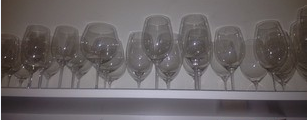As you know, I love using Riedel glasses of the proper shape to drink my wine. The thought of drinking a Montrachet in anything other than a Riedel Montrachet glass is less seemly than pouring the Montrachet in the toilet bowl and drinking it! I never drink wine from any other glass than my Riedel glasses when at home and unless I am certain that I can get really good wine glassware in a restaurant, I will bring my Riedel glasses (either my Vinum or my O glasses) along to the restaurant. There is no excuse for not wanting to get the very best experience out of wine drinking and the right glass plays a huge part in that.
And in that regard, it is important to clean your glassware properly! When cleaning my decanters, I only rinse them out with hot water or use a little bit of soap. I then make sure to rinse out the decanter with very hot water and refill and rinse six to seven times to ensure there is no soapy residue. About every 8th to 10th time I clean the decanter, I use a Polident capsule (‘Yes,’ the denture cleaner!) to remove any slight build-up of red wine film. However, the Polident capsule will leave a minty taste to it which could effect the taste of the next bottle decanted unless you make sure the decanter is perfectly cleaned. Therefore, after using the Polident to remove any film build-up, I wash out the decanter as usual with soap and rinsing it out six or seven times, and then I repeat the process in its entirety again.
I never put my Riedel glasses in the dishwasher as I have a concern that the dishwasher may break or in some way damage them. I know there are newer, nicer dishwashers in the Miele line that are Riedel-safe and that is great! I plan on buying one when I move into our own apartment unit. In my current rental unit, I wash my Riedel glasses by hand. I have been careful to wash the wine glasses first before using the washing implements to wash other dishes as the washing implements may contain more food particles or greasy or oily residue. However, I was not as careful and forgotten to do this with my drying towels!
Yesterday, I had used a Riedel Vinum Shiraz glass to enjoy a most magnificent bottle of the 1998 Tyrrell’s Vat 9 Shiraz to go with some great spaghetti my wife made. I had about a third of the bottle left that I finished off today while writing and doing other work at my computer. However, when I pulled the glass I cleaned yesterday out of the pantry, I sniffed it and it had an slight odor. I compared it to other glasses I cleaned previously, which were odor-free.
But the glass I used and cleaned yesterday definitely had an odor inside the glass when I put my nose to it. I tried to think what had happened and why it had a slight odor. I often clean and rinse my wine glasses and turn them upside down to dry. However, I make sure to turn them right-side-up quickly so as to not trap any odor in the globe. Then I dry them with a drying towel.
The problem was that my drying towel was over-used from having cleaned dishes the last few days and had built up some food odors on the towel. Therefore, when drying the Riedel glass, I transferred some of the food odors to the glass causing it to smell. I always sniff an empty glass before use and you should too. While rare, this was one time where I had failed to clean and dry the glass properly and it could have caused my otherwise great glass of 1998 Tyrrell’s Vat 9 Shiraz to be less than perfect due to the odor in the glass.
I never store my glassware upside down on a shelf as the rim of the glass will be sealed by the shelf. If there is any bacteria inside the glass, it can multiply and leave a poor odor in the glass, especially if it is sitting for weeks or longer. Therefore, I always store my glassware right-side up to allow it to breathe. I do so inside a closed cabinet so the glasses will not collect dust. The ideal way to store glasses is upside down (to eliminate any possibility of dust), but by hanging it by the base (see above picture). This requires you to install a rack to slip the base of the glass into. While this is the best way to store wine glasses, it does require you to buy and install the rack. This is not hard, but based on your living conditions, it may be difficult to find an area to mount the wine glass rack and store the glasses. I just keep mine inside the pantry (see below).
Make sure your wine glasses are:
- Cleaned properly;
- Dried properly; and
- Stored properly
Otherwise, your drinking experience will be less than satisfactory, even with the right Riedel glass and wine!
















